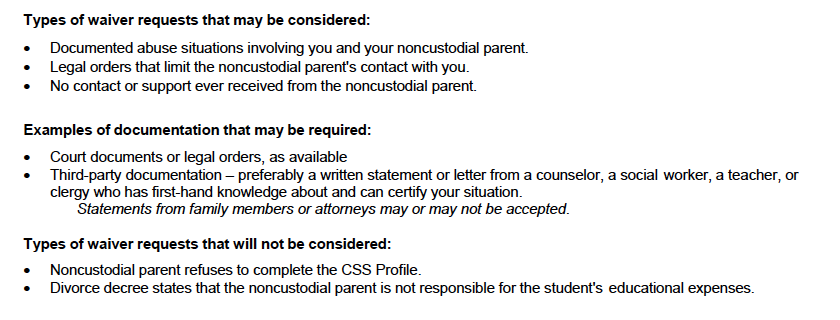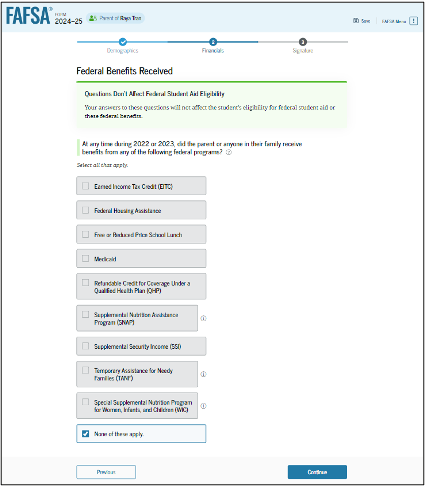¿Qué es el Índice de Ayuda Estudiantil?
La FAFSA 2026-27, o Solicitud gratuita de ayuda federal para estudiantes, es la solicitud principal de ayuda financiera basada en la necesidad para el año académico 2026-27. Un estudiante y uno o más padres presentan información financiera y del hogar. Con base en esta información, la FAFSA calcula la cantidad que una familia puede pagar por la universidad en un año determinado, llamada... Índice de Ayuda Estudiantil (SAI).
La oficina de ayuda financiera de una universidad utiliza el Índice de ayuda estudiantil En la siguiente ecuación simple, para determinar la elegibilidad de un estudiante para recibir ayuda financiera según la necesidad, dada la universidad Costo de asistencia.
Costo de asistencia
Índice de Ayuda Estudiantil (SAI)
_____________________________
= Necesidad financiera
Un estudiante Necesidad financiera es su elegibilidad para obtener ayuda en una universidad. Sin embargo, las políticas de cada universidad sobre la asignación de sus fondos institucionales basados en las necesidades determinan la oferta de ayuda financiera que finalmente recibirá un estudiante, que puede o no cumplir con las necesidades calculadas del estudiante. Necesidad financiera. Leer más
¿Cómo se calcula el Índice de Ayuda Estudiantil?
El tamaño de la familia, el estado civil de los padres, el estado de residencia, junto con cuatro factores financieros principales, determinan el Índice de Ayuda Estudiantil 2026-27.
- Ingresos de los padres en 2024
- Activos de los padres en la fecha de presentación
- Ingresos del estudiante 2024
- Activos del estudiante en la fecha de presentación
Un cambio significativo es que el número de estudiantes universitarios ya no se utilizará en la fórmula SAI.
1) Ingresos de los padres
La FAFSA 2026-27 se basa en las declaraciones de impuestos federales de 2024 para todos los ingresos de los padres, lo que elimina la necesidad de declarar ingresos no tributables que no se incluyen en las declaraciones de impuestos federales. Las contribuciones antes de impuestos a planes de jubilación patrocinados por el empleador (401k, 403b, pensión, etc.) ya no se consideran parte de los ingresos de los padres.
Si el padre o la madre no está obligado a presentar declaraciones de impuestos federales en 2024, el SAI será de -$1,500. Este paso se incluye en esta calculadora. Leer más
2) Activos de los padres
La FAFSA 2026-27 contabiliza los siguientes activos como parte del patrimonio neto de un padre disponible para pagar la universidad:
- De cheques
- Cuentas de ahorro/mercado monetario
- CD
- Cuentas de corretaje
- 529 o planes de ahorro para la universidad solo para el estudiante solicitante
- Valor patrimonial de segundas propiedades.
Se pueden contabilizar dos categorías adicionales como activos principales para el cálculo del SAI.
- Manutención infantil recibida.
Un padre declara toda la manutención infantil recibida durante el año calendario anterior a la presentación de la FAFSA como un activo. - Patrimonio neto del negocio o finca.
Si un padre o madre es propietario de un negocio o finca con más de 100 empleados a tiempo completo, el patrimonio neto se declara en la FAFSA. El patrimonio neto es el valor del negocio o finca menos cualquier deuda contraída con él. Un padre o madre que solo sea copropietario declararía su porcentaje del patrimonio neto total.
Activos protegidos son no contado en la FAFSA:
- Cuentas de jubilación: 401k, 403b, IRA, pensiones, etc.
- Seguro de vida
- Vivienda principal
La tasa de contribución del patrimonio neto total de los activos de los padres reportada es de aproximadamente 5%.
3) Ingresos estudiantiles
La FAFSA 2026-27 ofrece protección de ingresos para estudiantes de $11,770. Por lo tanto, no se prevé ninguna contribución de los ingresos del estudiante si los ingresos de 2024 son de $11,770 o menos. Por cada dólar que supere esta cantidad, la tasa de contribución es 50%.
4) Activos estudiantiles
Se declaran todos los activos que posee un estudiante fuera de su jubilación. Estos incluyen cuentas corrientes, de ahorro, certificados de depósito y cuentas de corretaje. Los planes 529 o de ahorro para la universidad que posee el estudiante siempre se declaran como activo principal. La tasa de contribución para los activos estudiantiles es de 20% por cada dólar.
Calculadora del índice de ayuda estudiantil FAFSA 2026-27
Para calcular su índice de ayuda estudiantil, utilice los valores de las declaraciones de impuestos de 2024 de los padres y del estudiante y el valor actual de los activos de los padres y del estudiante. Nota: Esta calculadora es para estudiantes dependientes.
¿Cómo se desarrolló esta calculadora?
Esta calculadora sigue la fórmula actualizada del Índice de Ayuda Estudiantil 2026-27 publicada por el Departamento de Educación en agosto de 2025. Puede descargar la hoja de fórmulas. aquí.
¿Qué significa un SAI negativo?
El Índice de Ayuda Estudiantil ahora puede ser tan bajo como -$1,500. Para determinar la elegibilidad de un estudiante (Costo de asistencia – SAI = Necesidad financiera/Elegibilidad), las universidades establecerán el SAI en $0. Sin embargo, la universidad podría considerar un SAI negativo al evaluar los programas universitarios para estudiantes con alta necesidad.


